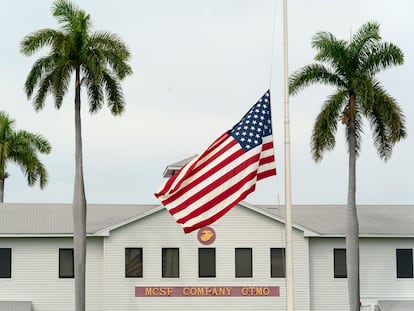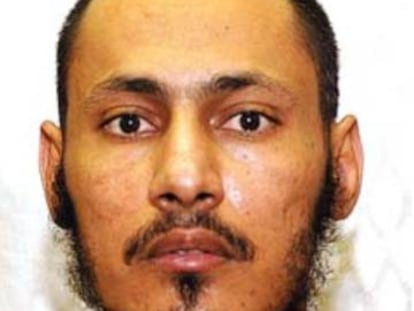Guantánamo: Two decades waiting for justice
Abd Al-Rahim al-Nashiri is accused of killing 17 people in the bombing of the ‘USS Cole’ destroyer and has been in prison since 2006; he claims that the CIA tortured him


Geographically, you will find Camp Justice at the U.S. naval base at Guantánamo Bay on the island of Cuba; it opened there in 2002. Spiritually, it is located at the intersection where the worlds of Franz Kafka’s The Trial, Samuel Beckett’s Waiting for Godot and Gabriel García Márquez’s One Hundred Years of Solitude meet.
A fenced enclosure surrounded by barbed wire fences and turrets that one can only access with special credentials, Camp Justice is the domain of military commissions, the particular military tribunals that the George W. Bush administration created in 2006 to try Guantánamo’s “enemy combatants” without granting them the rights that the Geneva Convention guarantees prisoners of war. It is a universe where those suspected of some of this century’s worst attacks have been waiting for their cases to come to trial for two decades.
It is a harsh, dusty place with prefabricated barracks hidden by fences where prominent signs prohibit photography, surrounded by barbed wire under the blazing sun. It literally imposes its own law: the military commissions employ a peculiar blend of U.S. criminal law and court-martials, based on the dubious principle that the persons prosecuted here do not have rights and are not on U.S. territory, so they cannot avail themselves of the judicial guarantees they would have there. For instance, Camp Justice’s system accepts hearsay testimony if it is considered to be reliable.
“This is a system set up to confuse things and keep them from being clarified, not to offer fair trials”A Guantánamo defense lawyer
Before heading to the base, a defense lawyer for the prisoners warns that “if what you see in court doesn’t make sense to you, [that’s because] it doesn’t [make sense]. This is a system created to confuse things and prevent them from being clarified, not to offer fair trials.” It’s a universe where everything seems provisional and precarious—the press center set up inside an old hangar, the barracks that house the cavernous courtroom—but everything has become permanent. The uncharted legal terrain in which the military commissions operate, the continuous appeals and controversy over the prison’s tortured past have made the pending trials eternal. Everyone is waiting for the trials but, like Godot, they may never come for the rapidly aging prisoners.
In a reflection of optimism, a new courtroom and 162 small, prefabricated units—living quarters for lawyers, witnesses and jurors in those future trials—are under construction. The yellow doors—and the U.S. flag, escorted by other military flags—are the only pops of color on the compound.

The Al Nashiri case
Over the past six months, Abd Al-Rahim al-Nashiri’s case has played out here in a series of preliminary hearings. He is accused of perpetrating the 2000 bombing of the USS Cole destroyer off the coast of Yemen, in which 17 U.S. servicemen between the ages of 19 and 35 were killed. If convicted, he faces the death penalty. That is, if the case ever goes to trial: the case of this Saudi of Yemeni descent, now 58, has been tangled up in the courts since his first preliminary hearing was held in 2011. The UN Working Group on Arbitrary Detention says that “his rights to a fair trial and due process have been repeatedly violated at Guantánamo.”
In 2002, Al Nashiri was captured in the United Arab Emirates and handed over to the CIA, which made him disappear for four years in its so-called “black sites” in Afghanistan, Thailand, Morocco, Poland, Lithuania and Romania. To make him reveal any information he might have about that attack and others, and any data he might reveal about future attacks, Al Nashiri was subjected to all kinds of psychological and physical torture there: waterboarding; painful positions; sleep deprivation; simulated executions; threats of raping his mother in front of him; his own anal rape. That continued until 2006 when he was finally transferred to Guantánamo; his current trial began in 2011.
Progress in his trial has been complicated by problems that are typical of this atypical judicial system. Military lawyers change frequently, both for the defense and the prosecution, and newcomers need time to get a handle on the case’s intricacies. The requirement that hearings be held at Camp Justice makes it difficult to transport witnesses, legal personnel and observers, who must adapt to the only available flight, a military charter that departs from Washington once a week, to participate in the hearings. These proceedings are frequently interrupted to deal with classified information behind closed doors.

Then there are this case’s specific problems. It has already gone through three judges. The current one, Lanny Acosta, will retire from the Armed Forces on September 30, which will force another replacement and probably further delays. There have already been several long delays: two years of rulings on the case had to be annulled and started anew after a higher court ruled that one of the previous judges had a conflict of interest.
This preliminary hearing will decide on the admissibility of a series of incriminating evidence and testimony against Al Nashiri. That includes a confession the defendant made in 2007—when he was already in Guantánamo—to a team of “clean” interrogators, who were not involved in torturing him. Led by lawyer Anthony Natale, the defense has asked that this confession not be admitted, arguing that Al Nashiri admitted his guilt conditioned by the memory of the torture to which he had been subjected for four years. Natale added that, after examining him in 2012, a doctor described Al Nashiri as “one of the most severely traumatized individuals” she had ever seen.
In support of his argument, throughout the hearing, Natale has cited, among others, a former Al Qaeda terrorist network investigator at Guantánamo and a psychologist who participated in the abuse of Al Nashiri and who graphically demonstrated some of the practices in those “enhanced interrogations,” as such torture was called at the time.
The prosecution, led by attorney Michael O’Sullivan, argues that the defendant was perfectly competent when he incriminated himself during three days of testimony before that “clean” team of interrogators, who had not participated in the torture. “That wasn’t a 15-, 20-minute confession; that was the long narrative of a lifetime,” prosecutor Ed Ryan argues. Among the evidence, he has presented testimony from the officers who interrogated him and a doctor who has testified in support of those arguments.
For her part, defense attorney Annie Morgan notes that the defendant had already been subjected to nearly 200 interrogations before being turned over to the so-called “clean team” of investigators.
Special security measures
One must obtain a special credential to gain access to the court premises (the credential must be kept out of sight on the rest of the base). Cell phones and all other electronic equipment are prohibited on the premises and must be kept in lockers. After storing electronic devices, two consecutive security checks await. No food or drink may be brought in.
With rows of seating for the defense, prosecution, and jury, the courtroom is already prepared for some indeterminate time in the future when the trials of the nine prisoners accused of a crime can proceed: in addition to Al Nashiri, there are five suspects involved in the 9/11 attacks—including the alleged mastermind, Khalid Shaykh Mohammed—and three suspects in the 2002 attack on a nightclub in Bali that killed 202 people. Over a dozen cameras record everything that happens in this large, windowless room, over which the seals of the U.S. Armed Forces preside.
A glass partition separates this room from the gallery where the observers—press, non-governmental organizations and the victims’ relatives and friends—sit. The latter are separated from the rest of the seats by a curtain.
This week there are only a handful of people in that gallery: three NGO representatives, three journalists and a couple of representatives of the victims of the attack on the USS Cole 23 years ago: the father of one of the deceased and a crew member. Although others can follow the case at a distance from Norfolk, Virginia (where the destroyer is based), the Pentagon or a room set up at another military base, fewer observers are coming to the base to watch the proceedings, attesting to the semi-oblivion into which Guantánamo—once one of the world’s most infamous prisons—has fallen.

Before each session begins, a soldier painstakingly reads the instructions to this audience. There’s no drawing, no scribbling on a piece of paper, no doing anything that might constitute disrespect to the court. Falling asleep is also forbidden; that “lack of decorum” can result in expulsion from the gallery.
Although the participants are seen at the hearing, they are only heard on closed-circuit television, which broadcasts with a 40-second delay. The court, over which Acosta presides, has a red button that can be pressed at any time to interrupt the transmission of a statement if it is potentially classified information, the military warns.
The accused never appears in the courtroom during this third and final week. Natale explains that he prefers to observe the proceedings from another safe place. His client suffers from serious vertigo, which, along with the strict security measures, make it difficult for him to move.
Those who have seen him explain that Al Nashiri is a small man—he is about 5′5″ (167 centimeters) tall—who appears at the hearing wearing a shirt and pants. He loves pop music—he is a fan of Dua Lipa—which has helped him learn to communicate in English. Unlike other prisoners, he is not religious, generously hugs his defenders and has no problem with female prison staff.
The third week goes by slowly, with constant interruptions to study evidence (the prosecution has announced that it has a series of videos of Al Nashiri’s statements from his cell) and testify in closed sessions and then to return to the open trial.
At the end of the last session, Judge Acosta does not discard the possibility of starting the trial against Al Nashiri in August, but he warns that it is “highly ambitious.” He will probably decide on the appeals in a couple of weeks: “This is Guantánamo; two weeks is fast,” he says ironically. Prosecutors and lawyers prepare to take the flight back. Maybe they will return here in a month; maybe they won’t. At Guantánamo, time is circular, and Justice is still waiting for Godot in a vortex where the worlds of Vladimir and Estragon, Citizen K and Aureliano Buendia converge.
Sign up for our weekly newsletter to get more English-language news coverage from EL PAÍS USA Edition









































